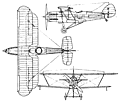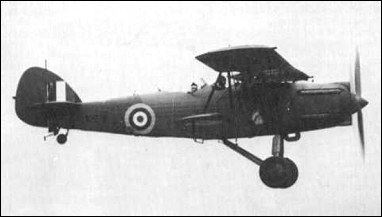|
| The Hector was developed as a two-seat army cooperation biplane based around a Hind-type fuselage, tail unit and landing gear and married to unswept biplane wings. A total of 178 were built for the RAF, entering service in 1937. These were stationed in the UK. Only a handful of Hectors were ever flown in anger, raiding German positions in occupied France in May 1940. Power was provided by a 600kW Napier Dagger IIIMS 24-cylinder H-type air-cooled and supercharged engine, giving a maximum speed of 301 km/h.
 | A three-view drawing (1298 x 1106) |
| ENGINE | 1 x Napier Dagger III MS "H", 600kW |
| WEIGHTS |
| Take-off weight | 2227 kg | 4910 lb |
| Empty weight | 1537 kg | 3389 lb |
| DIMENSIONS |
| Wingspan | 11.26 m | 37 ft 11 in |
| Length | 9.09 m | 30 ft 10 in |
| Height | 3.17 m | 10 ft 5 in |
| Wing area | 32.14 m2 | 345.95 sq ft |
| PERFORMANCE |
| Max. speed | 301 km/h | 187 mph |
| Ceiling | 7315 m | 24000 ft |
| ARMAMENT | 2 x 7.7mm machine-guns, 2 x 51kg bombs |
| Chris Pinn, e-mail, 20.05.2022 17:58 The top photo seems to show a Hector with a non-standard rear cockpit with windshield. Is there any detailed information on this? I have convinced myself it is K9711, but I may be wrong. reply | | Klaatu83, e-mail, 13.10.2015 16:11 The Hector was basically a version of the Hawker Hart powered by a Napier "Dagger" engine in place of the usual R-R "Kestrel" engine. The British put these same "Dagger" engines into the Handley-Page Hampton medium bomber, creating a version known as the "Hereford". The engines were considered so unsatisfactory that the type was quickly taken out of production and the aircraft powered by them relegated to training. reply | | bombardier, e-mail, 22.05.2011 12:55 An unreliable,obsolete by the time it was introduced and totally inefective in it's role.An embarrassment for the entire Hawker Hart family. reply | | Richard Anderson, e-mail, 29.03.2010 23:18 Extract from the obituary for my uncle Group Captain Alan Anderson Daily Telegraph 30 /12 /2002 - Leading a force of six Hector biplanes of No 613 Squadron on May 26 1940, he attacked enemy troops laying siege to remnants of the British Expeditionary Force trapped in the Citadel at Calais - this in an aircraft that was already obsolete, and had a maximum speed of only 170 mph.
Anderson exposed his Hector biplanes to both ground fire and the attentions of Me 109 and 110 fighters, creating a scene reminiscent of a Royal Flying Corps operation from the First World War. reply | |
| | WinstonBrittanica, e-mail, 26.05.2008 10:14 Referring to the "flown in anger" part - they were thrown in against the seemingly-unstoppable German army, as it advanced across France, in desperation. reply |
|
Do you have any comments?
|
| 
COMPANY
PROFILE
All the World's Rotorcraft
|







